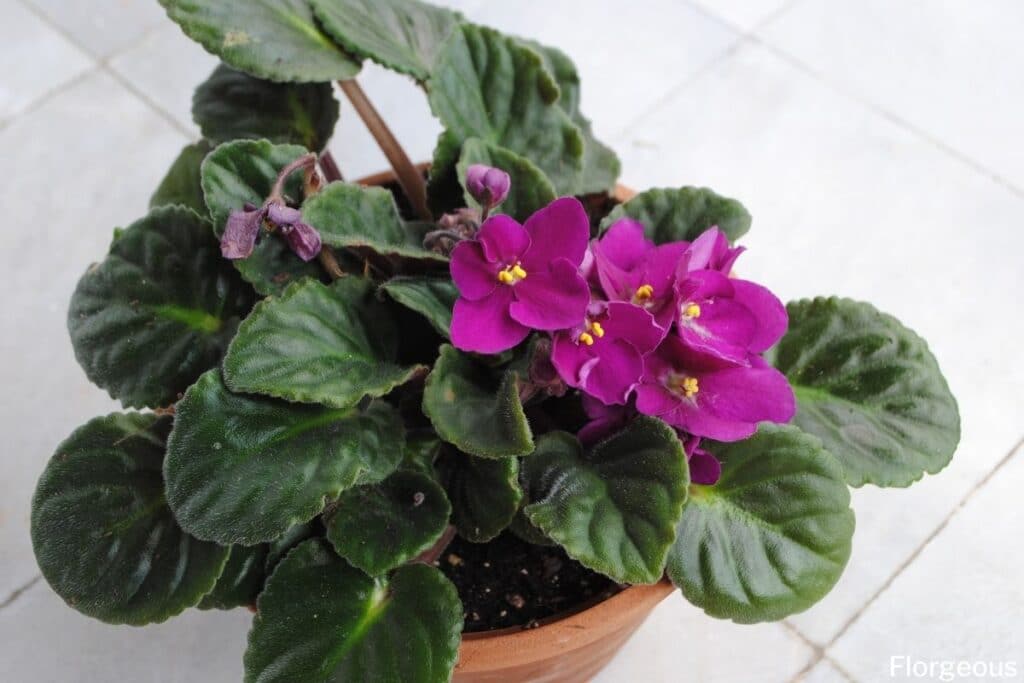With their all-year-round blooms and attractive foliage, African Violet plants have become a favorite among many gardeners, going as far as having their own grower’s society from all around the world.
Learn how to care for this beautiful ornamental below.
What is an African Violet?
The African violet is an ornamental plant with vibrant colored flowers and luscious green leaves. They belong to the section Saintpaulia within a larger genus Streptocarpus (subg. Streptocarpella). Saintpaulia is once thought to be a separate genus from Streptocarpus and is only recently transferred.
Consequently, African violets are sometimes commonly called saintpaulia. The name Saintpaulia was given to the plant in honor of its collector Baron Walter von Saint Paul-Illaire, who found the plant in Tanzania in 1892.
Despite the name, African violets are not true violets, nor are they related to them. They are from the plant family Gesneriaceae while the true violets (Viola) are from Violaceae.
African violets are one of the most beautiful ornamental plants. They are small and compact which makes them perfect as potted houseplants. The leaves are saucer-shaped and velvety, borne in short stems (3-4 inches).
They vary in shape and color which makes them one of the striking features of the plants. Nestled in the luscious green foliage is the main attraction, the brightly colored blooms. The stunning flowers, like the leaves, are variable from one cultivar to another.
They come in different colors, shapes, and number of petals. The plant has become a popular Mother’s Day gift because of the all-year-round blooms, signifying a mother’s love.
Plant Facts
| Scientific name | Saintpaulia ionantha |
| Common names | African violet, Cape Marigold |
| Family | Gesneriaceae |
| Plant Type | Houseplant |
| Height and Width | 4–6 ft. tall (indoors), 1–3 ft. wide (indoors) |
| Origin | Tanzania, Eastern Africa |
| Flower colors | White, Red, Pink, Purple, Blue |
| Foliage color | Bright green, deep green, grayish-green, cream-colored |
| Sun Exposure | Bright Indirect sunlight |
| Soil Type & pH | Slightly dry, good drainage, 6.2-6.5 pH |
| Special features | Beautiful blooms, houseplant, Prefers a slightly compacted roots |
How to Care for African Violets
Here are some common African violet care tips to know:
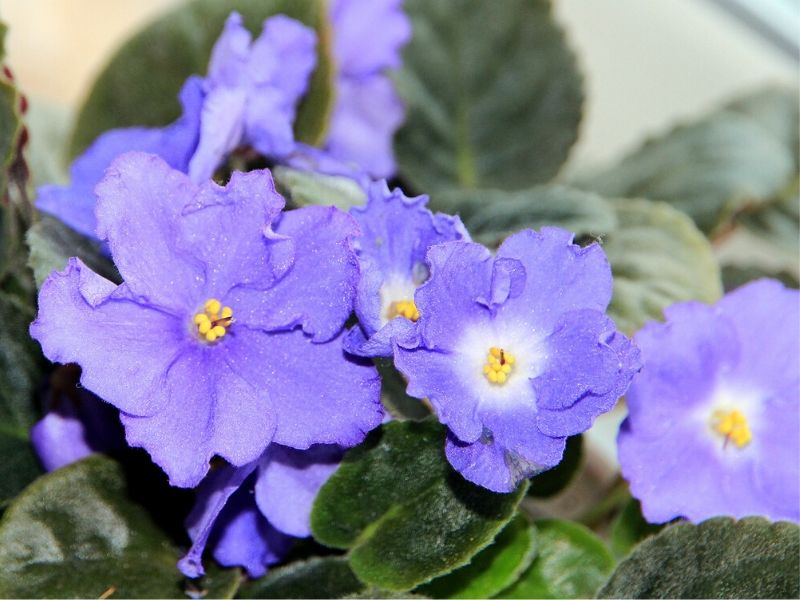
How much light does African Violet need?
For African violets, blooming is dependent on the amount of light the plant receives. Inadequate light may result in less bloom or no bloom at all. The light green leaves also tend to become weaker and have long petioles.
On the other hand, too much light causes distorted, tight growth, bleached leaves, and smaller flowers. The best blooms are achieved with moderate to bright, indirect sunlight.
Just make sure not to plant african violets in areas with direct sunlight because this can cause the african violet’s leaves to burn. Eastern and northern windows are the best places for African violets during warmer seasons. In winter, western and southern windows are best.
Some gardeners use artificial lighting for their plants such as 20 to 40-watt fluorescent lights suspended at 12 to 15 inches above the plants.
How Often Should I Water African Violet?
African violets need moderate watering to prevent root rot. It is important to keep the soil moist but not soggy. To ensure this, water african violets only when the soil surface is dry to the touch.
Stick your finger on the soil. If there are only minimal soil particles that stick on your finger, it means that the soil is dry enough. Avoid overhead watering as this may cause leaf spotting. To prevent leaf spotting, keep the watering close to the soil.
During the blooming season, the plant prefers to be slightly dry but not the point of wilting. Remember to observe and listen to what your plant needs. If the leaves start to droop and the soil is dry, apply some room temperature water. Do not put too much water in an attempt to revive the plant as it may cause stress and shock.
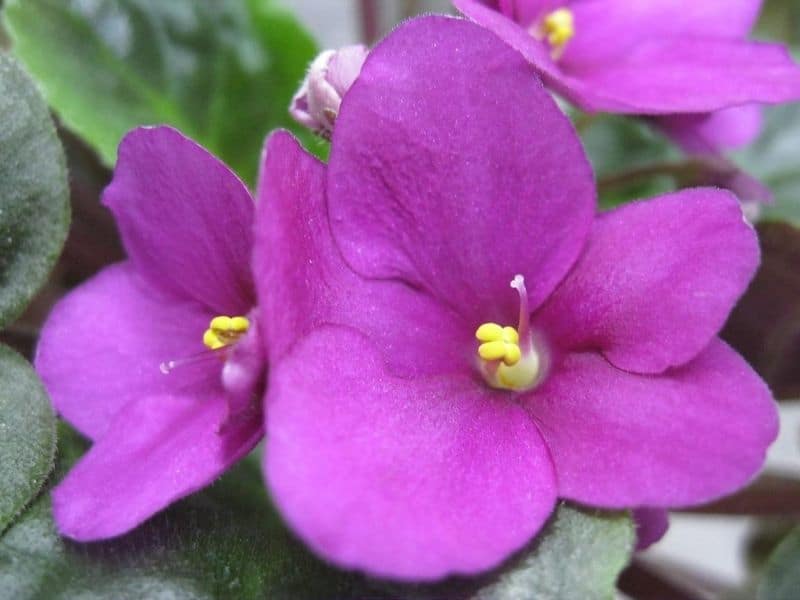
Temperature and Humidity
African violets grow best in moderate temperatures between 70 – 80F in the daytime and 60 – 70F in the nighttime. They are not cold hardy, and below 60F, plants will become deformed.
These plants also require high humidity for attractive growth. Maintain high humidity by placing the pots in a water tray filled with pebbles. Misting should be avoided since the velvety leaves tend to retain water droplets, causing leaf spotting and fungal growth.
Soil/Potting Media
African violets prefer a light, slightly acidic (pH=6.8), porous, potting mix. It should provide air circulation for the roots, well drainage, and good moisture retention.
There are commercially available potting mixes made especially for African violets, but some gardeners prefer to mix their own. If you want to do so, you can use a 1:1:1 mix of sphagnum peat moss, perlite, and vermiculite. Make sure to use a soil test kit for optimal results.
Sometimes, the commercial African violet potting mixes can be too packed and hold too much moisture. If that is the case, you can remedy it by mixing with a general-purpose organic potting medium in a 1:1 ratio.
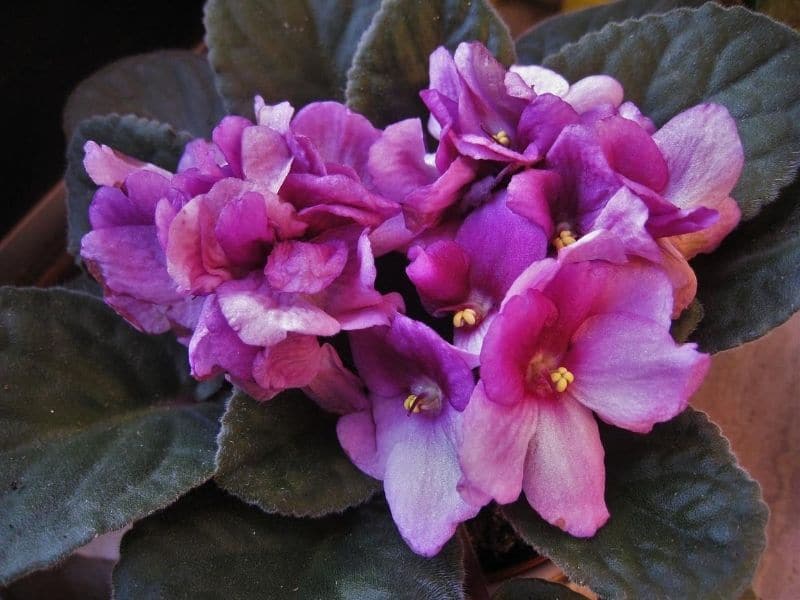
Fertilizer
The fertilizer for African violets depends on the cultivar. The first thing to do is to know what plants need, which are the major elements nitrogen, phosphorus, and potassium. For the African violets, complete fertilizers with 20-20-20 or 14-14-14 are enough.
Choose a slow-release or liquid fertilizer and dilute the fertilizer in water to avoid overfertilization that might lead to salt build-up. Overfertilization and salt buildup will cause complications with the roots and stems of the plant.
In terms of the time of african violet fertilizer application, it is best done during the growing season. Avoid adding fertilizers during the blooming season as it may inhibit flower production. If you want some help with the blooming of the plant, you may want to opt for a phosphorus fertilizer and avoid nitrogen fertilizers. Nitrogen fertilizers will only promote foliage growth.
If you are not sure about what type of fertilizer your plant needs, have a soil test. This test will tell you the available and lacking nutrients for your plant.
Repotting
The best time to repot and transplant African violets is by listening to what the plant needs.
Generally, Saintpaulia prefers to be root bound so repotting should be done only when they outgrew their pot. Although, as a general rule, it should be transplanted or repotted twice a year. Doing this, it will allow the plant to grow and flourish.
When repotting African violets, select a slightly bigger pot and remove most of the soil leaving only the portion attached to the roots. This step is called soft transplanting. Transfer the African violet into a bigger pot and add soil on the sides of the pot. Although, if overcrowding occurs, divide the plant to propagate or simply repot in an African violet mix.
Although it is not a complex activity, there are some steps you would need to take to have a successful propagation. Read the Top 3 Effective Ways to Propagate African Violets for a more detailed and in-depth explanation and tips for propagation.
Grooming/Pruning
Saintpaulia plants, especially rosette types, can be pruned to maintain a single-crown look. Pruning will also encourage new growth. When pruning African violets, remove dry or dying leaves and flowers by snapping them off. To prevent an unsightly bushy look, suckers or side shoots could also be picked off.
Propagation
Propagating African violets is commonly done by leaf-petiole cuttings. You can also increase your plants by dividing during potting, directly from seeds, or through suckers (for chimera types) (8). If the different methods of propagation are compared based on the time needed to have an established plant, dividing is the best way to go. Dividing the existing plantlets from the mother plant is the fastest way because the plantlets already have roots.
On the other hand, leaf cuttings come second in terms of ease. If leaf cuttings are used, the application of rooting hormones will help promote root development faster. Normally, the cuttings will take 12 weeks to have a sturdy and healthy plant enough to transplant.
In all these methods, remember to prepare the right African violet soil mixture. If a premade growing mix is not available, choose soil that is loose and has good drainage. Root rot may be avoided by having the right soil.

Diseases and Problems
African violets have 2 common insect pests, spider mites, and mealybugs. Both of the said insects are sucking insects and they plague the dark green leaves. They are often seen on the underside of the crevices of the plant. Pesticidal soaps may be a quick solution for a mold infestation.
On the other hand, the African violet often has fungal diseases, such as botrytis blight and root and crown rot. Although fungal diseases have no known cure, it is best prevented with the use of protective fungicides and eradication of infected plants or plant parts.
Aside from insects and pathogens, problems with the African violet may arise because of the environment. For example, petiole rot is caused by salt accumulation on the rims of the pot. It may be resolved by flushing it out with large amounts of water.
Another common problem is water spots, which are caused by the drying of water droplets on the leaf surface. This problem is more prominent during cold temperatures. To avoid this from happening, follow the mentioned water requirement earlier in this article.
Lastly, some African violets struggle to bloom. This is often caused by a combination of incorrect growing conditions, including low humidity, overwatering, and waterlogging. If you notice African Violet leaves turning yellow, it’s essential to address these factors to promote healthy blooming.
Your plants might get these pests, diseases, and problems at some time, check our guide on how to deal with African violets problems and diseases.
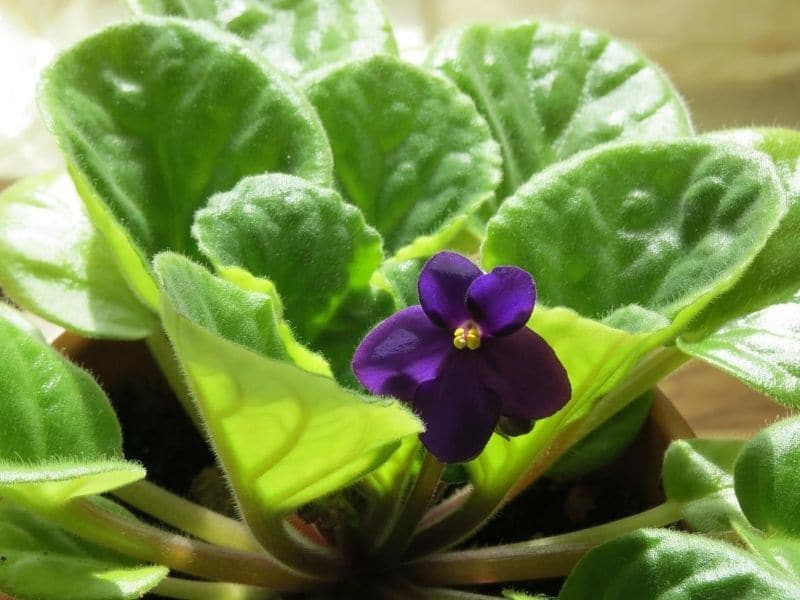
Types and Cultivars of African Violet
Despite the collector being European, African violets were first cultivated in Los Angeles in 1925. Since then, the plant has gained popularity throughout the US. More species were discovered, and many cultivars of the plant have been developed. Nowadays, the beauty of these flowers is recognized worldwide.
Saintpaulia cultivars can be categorized based on size, growth habits, flower variation, and leaf variation.
Based on the growth habit, an African violet can either be a rosette (single-crowned) type or trailing (multi-crowned) type. A rosette type would have leaves growing outwards from a central stem and flowers blooming at the center. On the other hand, trailing types would have several branches growing from the base and flowers blooming from each branch.
Based on size or the diameter of the plant, Saintpaulia can either be micro (less than 3 in.), super-mini (3-4 in.), mini (between 4 and 6 in), semi-mini (between 6 and 8-10 in.), standard (between 8-10 and 12-16 in.), or giant (over 12-16 in.).
Based on the flower variations, Saintpaulia can be a single type with 5 petals, a double type with 10 petals, or a semi-double type with 6-9 petals. The flowers can also exhibit variations based on the color/s, and shape of the flowers and the petals.
Based on the leaf variations, a Saintpaulia plant could be a boy (plain leaf), girl (scalloped margins with a white dot at the base), longifolia (long and pointed), ruffled, spoon-shaped, or quilted. They can also have variegation of white, cream, pink and yellow-green.
Thinking about adding this spectacular plant to your indoor collection? Check out some of these cultivars.
‘Blue Boy’
The first African violet cultivar, this plant has plain circular leaves and single type, blue petaled flowers. Perfect if you are looking for something simple.
‘Red Lantern’
This cultivar is on the elegant side with plain circular leaves and pansy-type flowers that have mauve-colored petals with creamy-white edges.
‘Tommie Lou’
This cultivar’s main feature is its foliage of green velvety leaves with creamy white variegation patterns on the edges. The blooms are equally showy with double-type white flowers, complementing the variegation of the leaves.
‘Tomorrow’s Pink Ice’
Another elegant cultivar, ‘Tomorrow’s Pink Ice’ features light pink, pansy-type flowers with raspberry edges.
FAQs
How do you care for African violets indoors?
African violets thrive in bright, indirect light and prefer well-draining soil kept consistently moist. Water them from the bottom to avoid getting water on the leaves, and maintain moderate humidity levels around the plant.
Are African violets easy to keep alive?
Yes, African violets are generally easy to keep alive when provided with the right growing conditions. With proper care, they can bloom continuously and add vibrant color to indoor spaces.
Why are my African violet flowers dying?
African violet flowers may die prematurely due to various factors such as underwatering, overfertilization, insufficient light, or fluctuations in temperature or humidity. Ensure the plant receives adequate care and address any issues promptly to prolong the flowering period.
How do you keep an African violet blooming?
To encourage African violets to bloom, provide them with bright, indirect light, maintain consistent watering, and fertilize them lightly every 4-6 weeks during the growing season. Remove spent flowers promptly to encourage the production of new blooms.
If you love African flowers, check this list of African flowering plants!
References
Reference list
1 “Saintpaulia ionantha”. Missouri Botanical Garden Plant Finder.
2. Stork J., Stork K. “You Can Grow African Violets: The Official Guide Authorized by the African Violet Society of America, Inc.”. iUniverse. 2007.
3. “Introduction to African Violets”. Baby Violets. 2020.
4. ‘African Violet Plant Size’. Grow African Violets. 2013. (online)
5. “African Violets: Variety is Beautiful!”. The Generiad Reference Web. The Gesneriad Society 2020.
6. Deardoff D., Wadsworth K. “What’s Wrong With My Houseplant?: Save you Indoor Plants With 100% Organic Solutions”. Timber Press. 2016.
7. Thomas P.A. “Growing African Violets”. The University of Georgia College of Agricultural and Environmental Science. Circular 660. 2012.
8. (Pruning) Burton J. “Indoor Gardening & Urban Gardening: Discover how to create Urban Gardens and master the art of Indoor and Balcony Gardening”. Amazon. 2010. P 60
Close

